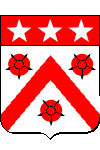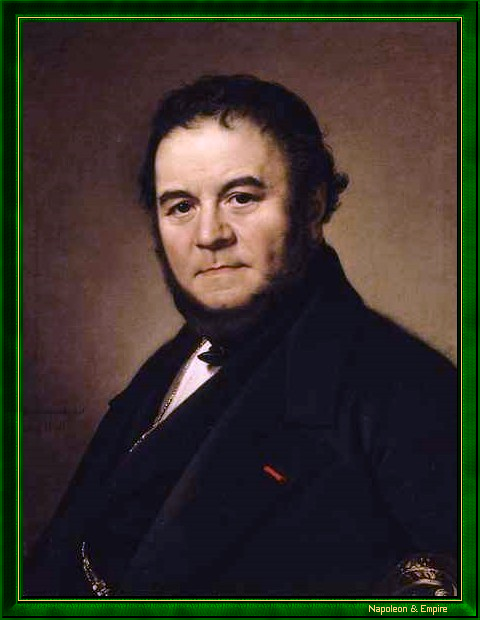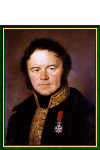Henri Beyle, a.k.a. Stendhal
Pronunciation:

Henri Beyle was born in Grenoble, French Alps, on January 23, 1783, into an esteemed bourgeois family. A student at Grenoble's Ecole Centrale, he went to Paris in October 1799 to take the competitive entrance examination for the Ecole Polytechnique, but failed.
In 1800 and 1801, he took part as a cavalry second lieutenant in the second Italian campaign, a country he immediately fell in love with. Initially hostile to the Empire, he changed his opinion in 1806 when his cousin, Pierre-Antoine Daru, brought him into the administration as assistant to the commissioners of war.
In this capacity, he served in Germany until 1808, then in Austria, where he took part in the Wagram campaign in 1809.
Auditeur at the Conseil d'Etat on August 1, 1810, in 1812 Stendhal was entrusted with carrying the ministers' correspondence to the Emperor at the height of the Russian campaign. He arrived in time to witness the battle of Borodino, and then took part in the disastrous retreat.
Having received no recognition for his ordeal (no title, no promotion, no medal), Stendhal let his zeal cool during the last days of the Empire, and fled to Italy in 1814.
Aware that the most exciting part of his life was behind him, Stendhal had to resign himself to being an obscure diplomat and a great writer without an audience.
He lived in Italy from 1815 to 1821 with his successive mistresses, writing several short stories and essays, including Rome, Naples and Florence (September 1817), the first work published under the pseudonym Stendhal, and De l'amour, before being expelled from Milan for carbonarism.
Back in Paris, ruined, he had to live off his pen. He frequented the literary salons and even made a disciple of the young Prosper Mérimée, kept a musical and pictorial column in the Journal de Paris, and published numerous essays. Armance, Stendhal's first novel, was published in the capital in 1827, followed in 1830 by Le Rouge et le Noir, which met with some success. That same year, Stendhal returned to the peninsula following his appointment as consul in Trieste by the new authorities following the July Revolution.
Rejected by Austria, he was transferred to Civita-Vecchia, where he became deeply bored, despite the time he devoted to writing several unfinished works (Lucien Leuwen, Vie de Henri Brulard).
In 1836, Stendhal was granted a three-year leave of absence from Paris, which gave him the stimulus he needed to complete his work. This enabled him to complete his masterpiece, La Chartreuse de Parme, in just a few weeks (1839). He then returned to Italy.
On March 15, 1841, he suffered his first stroke. Authorized to come to Paris for treatment, he suffered a second one on March 22, 1842, on the sidewalk of the Rue Neuve des Capucines, and died during the night. The funeral ceremony at Notre-Dame-de-l'Assomption church was followed by burial in the Montmartre cemetery , Paris.
"Henri Beyle, a.k.a. Stendhal", by Johan Olaf Södermark (Landskrona 1790 - Stockholm 1848).

From 1815 to 1836, Stendhal worked on a Life of Napoleon, which was not published until after his death.
Passionate about opera and painting, and a lover of Italy, Stendhal introduced Gioacchino Rossini to Paris, and proved himself an astute and rigorous critic beneath the false airs of a dilettante he liked to give himself.
In 1815, he had written on his visiting card, Waterloo, c'est trop dommage. Another six months and I'd have been appointed Prefect of the Sarthe department in Le Mans
.
In 1942, the French Postal Service released a 4.00 Franc stamp bearing the image of Stendhal .
He became a famous novelist after the fall of the French Empire: Armance, Le Rouge et le Noir (The Red and the Black), Lucien Leuwen, La Chartreuse de Parme (The Charterhouse of Parma).
Address
26, Rue Cambon. Paris 1er arrondissement
This is where Henri Beyle, the future Stendhal, resided, from 1810 to 1814.8, Rue de Caumartin. Paris IXème arrondissement
Stendhal was a subtenant there from June 1837 to the end of 1838; he improvised and dictated La Chartreuse de Parme in 52 days, from November 4 to December 26, 1838.Other portraits

"Stendhal in Consul uniform", painted towards 1835-36 by Silvestro Valeri (Rome 1814 - Rome 1902).